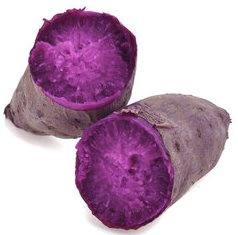Purple sweet potatoes

What is purple sweet potato?
Purple sweet potatoes are sometimes mistakenly called purple yam. Brown, reddish-orange, or orange or white fleshy white-skinned sweet potato native to Colombia and South Central America. After the discovery of Columbus, these were brought to Asia, and varieties of white-skinned and spotted pale purple flesh were made on the island of Okinawa, Japan. Today, they are widely grown and exported to the mainland of the United States, where they are popular with the Asian and Latin communities.
Purple sweet potatoes are medium to large in size and long, cylindrical and rectangular with a somewhat uniform shape. Purple sweet potato is basically a vegetable. The tubers are dotted to the point at both ends and, like other sweet potatoes, are members of the genus Ipomoea (genus Yam Dioscorea). There are two main varieties – Okinawa (white skin) and Stokes (purple skin) – although they share the characteristics of deep purple flesh. These potatoes are high in antioxidants.
These sweet potatoes are easy to prepare and cook. These potatoes can be cooked in the same way as a fun and familiar white sweet potatoes. Although some species have white skin, an open cut will surprise them with purple. Popular in some Asian and Latin cuisines and known for their dark purple color. It is intense during cooking and comes in vibrant color from the phytochemical anthocyanin, an antioxidant that enhances immunity. These potatoes are most commonly used in cuisine for their unusual color and as a natural food dye. Cooking takes more time than other varieties of sweet potatoes, but if cooked properly, the potatoes will be tender and moist. These sweet potatoes are best suited for cooking applications such as baking, steaming or roasting. The flesh of these potatoes is drier than most varieties, so adding one or two tablespoons of liquid to the recipe will achieve a more desirable flavor.
Purple sweet potatoes Nutrition Facts
Serving Size: serving (80g)
Nutrient Value
Calories 80
Total Fat 0.2g
Sodium 30mg
Total Carbs 19g
Dietary Fiber 2g
Total Sugars 5g
Protein 1g
Purple sweet potato benefits
Rich in antioxidants
For most whole foods, the darker and deeper the color, the higher the antioxidant levels. The Sweet potatoes with orange flesh are rich in beta carotene, such as carrots. When purple meat is rich in anthocyanins, such as blueberries, a type of flavonoid. Anthocyanins have been linked to reduced risk of many chronic diseases.
Fights against disease
One study found that men who ate purple potatoes instead of white potatoes every day for six weeks had lower inflammation, with higher levels of carotenoids, anthocyanins and phenolic acids. . Over time, this can be associated with lower blood pressure, lower cholesterol and reduced risk of heart disease and certain types of cancer.
Lowers blood pressure
Yes, that’s right. Purple potatoes keep you cool. Another study from Plant Foods for Human Nutrition found that eating a medium purple potato every day instead of a medium white potato significantly reduced blood pressure in just two weeks.
Lowers blood sugar
Purple potatoes may also be better than their pale cousins in terms of blood-sugar effects. Research in the Journal of Food and Function has shown that high levels of antioxidants in these dark-colored tubers may be related to lower glycemic index. Although sweet potatoes of all colors contain more sugar, they are considered “low” on the glycemic index scale compared to ordinary white potatoes. This means your blood sugar will rise more slowly, preventing a sharp spike and subsequent crash.
References:
https://www.thespruceeats.com/